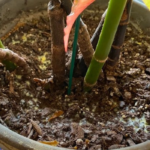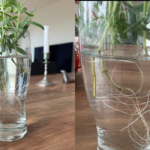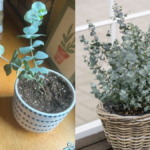How to Care for a Eucalyptus Plant is simple if you give it the right sunlight, proper watering, well-draining soil and a suitable growing environment. This plant grows fast, has silver-green aromatic leaves and can be grown in pots or directly in the ground. With correct care, it stays healthy for many years.
I have been growing eucalyptus in my garden and pots for the past few years. In the beginning, I faced problems like drying leaves, slow growth and overwatering issues. But with time and experience, I understood how this plant behaves and what it needs. In this post, I am sharing all the tried and tested care tips from my personal gardening experience.
About Eucalyptus Plant
Eucalyptus is an evergreen tree originally from Australia. It is famous for its strong fragrance and medicinal uses. Smaller varieties like Eucalyptus Gunnii, Eucalyptus Baby Blue and Silver Drop are suitable for home gardens and pots.
| Feature | Details |
|---|---|
| Common Name | Eucalyptus |
| Plant Type | Evergreen tree or shrub |
| Origin | Australia and surrounding regions |
| Leaf Type | Silver-green, aromatic |
| Growth Speed | Fast |
| Grown In | Outdoor gardens, balconies, large pots |
Best Time for Planting Eucalyptus
From my experience, the best time to plant eucalyptus is early spring or early monsoon. During this time, the temperature is mild, soil has natural moisture and the plant gets a good start.
| Season | Suitable for Planting? | Why |
|---|---|---|
| Early Spring | Yes, best time | New growth starts, weather is balanced |
| Early Monsoon | Yes | Soil stays naturally moist, root growth is good |
| Autumn (after rains) | Good | Soil is moist and temperature is stable |
| Summer (Peak heat) | No | Hot sun can burn young plant and dry soil |
| Winter | Not ideal | Slow growth, cold stress |
When I planted eucalyptus in early spring, it established faster and started producing fresh new leaves within a few weeks.
Quick Care Tips – How to Care for a Eucalyptus Plant
- Light: Needs full sunlight for at least 6 hours daily
- Watering: Water only when the top soil becomes dry
- Soil: Use well-draining, sandy or loamy soil
- Humidity and Temperature: Prefers low to moderate humidity and warm temperature
- Fertilize: Feed lightly during spring and summer
- Propagate: Can be grown from seeds or stem cuttings
- Common Problems: Yellow leaves, dry leaves, root rot, fungal infection
Watering the Eucalyptus Plant
In the beginning, I watered my eucalyptus daily, thinking it needs more water for fast growth. But soon the lower leaves started turning yellow due to excess water. Eucalyptus is drought-tolerant and does not like wet soil for long periods.
My watering routine now:
- I water only when the top 2–3 cm of soil feels dry.
- In summer, I water every 3 to 4 days.
- In winter, watering once in 7 to 10 days is enough.
- I avoid standing water in the pot tray to prevent root rot.
This method keeps the plant healthy and prevents fungal issues.
Best Soil for Eucalyptus
Eucalyptus grows well in light, airy and well-draining soil. Heavy clay soil is not good because it holds too much water.
My soil mix for potted eucalyptus:
- 50% garden soil or sandy loam
- 30% sand or perlite
- 20% compost or vermicompost
For garden planting, I make sure the soil is loose and water does not stay around the roots.
Sunlight Requirements
Eucalyptus needs full sunlight to grow properly. If it does not receive enough light, it becomes weak, tall and thin.
From my experience:
- Keep the plant in a location where it gets minimum 6 hours of direct sunlight.
- Outdoor sunlight is best, but if growing indoors, place it near a south-facing window or balcony.
- If sunlight is very harsh in summer, give light shade during afternoon hours to protect young plants.
Humidity and Temperature
Eucalyptus naturally grows in dry and warm areas. So, it does not require high humidity like tropical plants.
- Ideal Temperature: 15°C to 30°C
- Humidity Level: Low to moderate
- Air Circulation: Needs fresh air and open space
I avoid spraying water on eucalyptus leaves because this may cause fungal infection. Instead, I focus on good sunlight and airflow.
Fertilizing the Eucalyptus
Eucalyptus grows fast but does not require heavy feeding.
What I follow:
- I apply a mild liquid fertilizer once a month in spring and summer.
- Adding compost or cow dung manure every 2 to 3 months supports healthy growth.
- I do not fertilize in winter or when the plant is newly planted or under stress.
Propagating Eucalyptus
You can grow eucalyptus from seeds or stem cuttings. I found seed propagation more successful.
Seed Method:
- Take fresh eucalyptus seeds.
- Sprinkle them on moist soil and press gently.
- Do not cover with thick soil.
- Keep in bright light (not direct sun).
- Seeds sprout in 2 to 3 weeks.
Stem Cutting Method:
- Cut a young stem around 10–12 cm long.
- Remove lower leaves and keep the top leaves.
- Dip the bottom in rooting hormone (optional).
- Plant in moist sandy soil or perlite.
- Keep in indirect light until roots develop.
Common Problems and Solutions
| Problem | Reason | Solution |
|---|---|---|
| Yellow leaves | Overwatering | Reduce watering and improve soil drainage |
| Dry brown leaves | Heat or underwatering | Water properly and avoid strong afternoon sun |
| White powder spots | Fungal infection | Increase airflow, use neem oil spray |
| Slow growth | Low light or poor soil | Give full sunlight and add compost or fertilizer |
| Root rot | Waterlogged soil | Repot with well-draining soil, cut damaged roots |
Conclusion
Eucalyptus plant care is simple if you understand its needs. Full sunlight, well-draining soil, controlled watering and good air circulation are the key points. I have grown this plant both in pots and in the garden, and it has always given fresh, fragrant leaves when cared for properly.
This guide is based on my real gardening experience and practical methods that truly work.











